#Cassabanana
Text
Dungeon Daidokoro- Delicious in Dungeon in The Kitchen #2
(Daidokoro is kitchen in Japanese)
Ok, so the last one got 90-ish notes. Close enough.
I am going to open this one with a request for tips and donations if you like my work. I'm looking at, like, $350 to get my car re-registered because of DMV bullshit that I can't really fix. I have some money, but if people could help with this, I'd be eternally grateful.
So, please, if you can, if you like my work with this, my cashapp is $ValravenApocalypse, my paypal is paypal.me/korbl, my Venmo is @ Valraven. Anything would be a big help.
Man-Eating Plant Tart
In chapter two, Team Laios ventures into the second layer of the dungeon, a large apparently open-air space full of trees and lush foliage. The first meal they eat here is a tart made of man-eating plant fruit.
Which is a difficulty here.
First, there are no man-eating plants. Obviously. Like, we're not even dealing with something like "there aren't giant scorpions (but there are large crustaceans)" or "there aren't walking mushrooms (but there are big mushrooms)." This is just... this thing doesn't exist. There are carnivorous plants, but they're rather small and, to my knowledge, don't really fruit.
There are giant (non-tree) plants, but, to my knowledge, they also don't fruit, and they tend to be in the realm of "pollinated by carrion insects, so they smell like rotten meat." So, even if that giant flower that smells like corpses has fruit, I doubt anyone would want to eat it.
But, let's start by looking at the recipe-
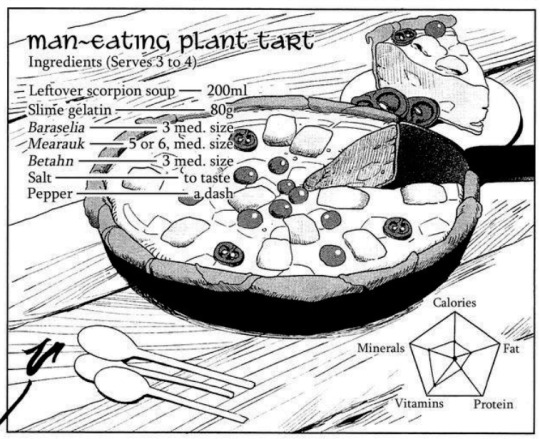
So, to start with, you need some leftover "scorpion hotpot." Which is to say Lobster Portabello Soup, and some Slime Gelatin--which is maybe jellyfish, but I don't think you can really get anything like gelatin from a jellyfish (at least that you'd want to eat), so we're probably looking at agar agar (a gelatin-like substance from seaweed).
Baraselia, Mearauk, Betahn
It's difficult to really figure out similar real fruits to these. In fact, it's not even particularly clear which fruit is which in the manga. But, I did find Ingredients on the wiki, which makes it more clear-



(minor transliteration differences aside)
Baraselia is interesting, its seeds seem similar, broadly, to a pepper's, and led me to initially think it might be basically a bell pepper-
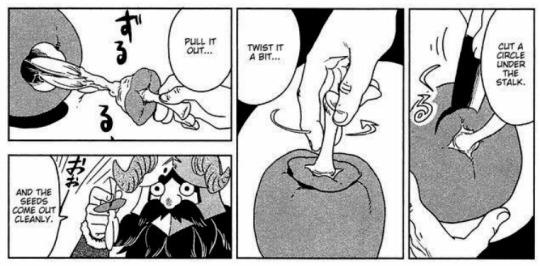
But the more I thought about it, the more I realized that a bell pepper's flesh wouldn't stand up to heat the way the baraselia's does

On further thought, I think the baraselia is a bit more like a squash. Thinking about it, pumpkin seeds also cling pretty tight to the stem, but I don't think the baraselia is a pumpkin exactly.
I think a Cassabanana is probably pretty close-
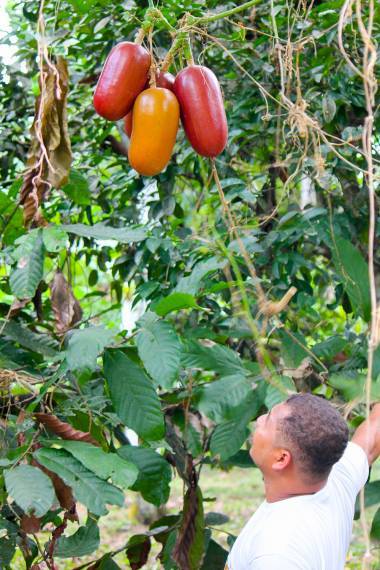
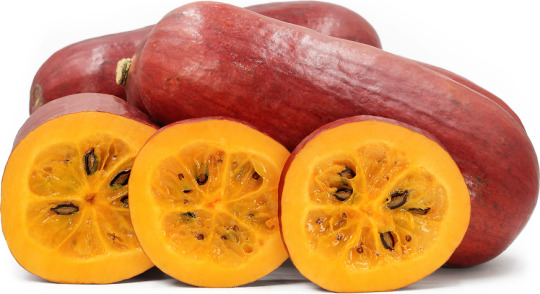
And, while I'm completely unfamiliar with this plant, I saw notes online that the unripe fruits can be cooked like a vegetable. So, I think cassabanana is probably a good candidate for "Baraselia."
I think the betan is the chopped fruit that gets mixed in. It's an interesting looking fruit, particularly in the anime-

It has a vaguely chili-like appearance, which it could well be, but I'm also struck by the visual similarity of the inner nodes of jackfruit-

Jackfruit is noted for it's "meaty" texture, and is used in several savory dishes. I think jackfruit is probably a very good candidate for a Betan stand-in.
Which leaves Mereoak/Mearauk-
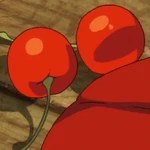

Honestly, they look a lot like cherries or tomatoes, and tomatoes used in savory tarts are just, like, a thing. I think you could very well use a mix of cherries and cherry tomatoes for mereoak.
"Man-Eating Plant" Fruit Tart
~7 oz Leftover "Scorpion Soup
~3 oz Agar Agar or Gelatin
~1 lb unripe Cassabanana
~10 oz jackfruit, roughly chopped
5-6 cherry tomatoes, 3-4 cherries
Salt to taste
Dash of pepper
Lightly steam the fruits and let cool until you can safely handle them. Cut open the cassabanana and remove the seeds, then the skin from the flesh. Mold the skin into a shell for your tart, outside against the plate.
Mash the cassabana flesh, and add the gelatine and soup, stir until slightly thickened. Taste, adding salt and pepper as needed. Add the chopped jackfruit and the rest of the soup, stir till well combined and pour into tart shell.
Put in oven at 400 degrees. Check for setness at 15 minutes, and give an additional 5 minutes if needed.
Remove once set, let cool slightly, serve.
#dungeon meshi#delicious in dungeon#Defictionalization#Cooking#Food#Man Eating Plant Tart#Cassabanana#Jackfruit#Tomatoes#Cherries#I actually don't know how well this would work because a lot of the ingredients are things I've not worked with but I *think* it would work#Again if you like this#reblog#like#and consider helping me get my car legal to drive again#*passes around the virtual hat*
38 notes
·
View notes
Text

Cassabanana
Also known as casbanan, sikana, puttigel and musk cucumber
41 notes
·
View notes
Text
Seems like a cool thing to crop...
1 note
·
View note
Photo

another ref sheet!
#my art#my ocs#cassie#angolo#cassabanana#pepino angolo#fruit characters#fruit ocs#character ref#character ref sheet
10 notes
·
View notes
Photo

New to sprout in the nursery are sicana odorifera, a large, herbaceous perennial vine native to tropical South America, grown as an ornamental plant and for its sweet edible fruit. English names include cassabanana or casbanan, sikana, and musk cucumber. The fruit is large, up to 60 cm long, with skin of variable color. The fruit has a delicious, melon-like taste when it is ripe, which needs high temperatures to ripen. The sweet, aromatic, yellow-to-orange flesh of the mature fruit is eaten raw or made into preserves. The immature fruit can be cooked as a vegetable. #growninhaiti #chocolatecasabanana #sicanaodorifera #vibe #fruit #nursery #exotic #tropical #growth #organic #haiti #ayiti #nogmos #nopesticides #noherbicides
#vibe#growth#organic#haiti#exotic#tropical#fruit#sicanaodorifera#nursery#nopesticides#noherbicides#nogmos#chocolatecasabanana#ayiti#growninhaiti
1 note
·
View note
Note
Still bored? *tries to think of something interesting* I got hit in the face by a chicken this morning; we’re both fine. Aside from writing, do/did (I know kids put a dent in/obliterate free time) you have any other hobbies? Are there any Bobby movies you haven’t seen that you want to? Have you ever tried cassabanana? It’s apparently grown and eaten in Louisiana, but it’s native to South America. I live in Southern California and want to grow them, but I don’t know of it’s humid enough here.
Not really. I’m watching Russian Doll with my husband. We’re on episode 4 and I still have no clue what’s going on, but I like it.
Do you live on a farm? I can’t imagine what other situation would give you a face full of live chicken.
Aside from writing I like to read. I love to travel. I like to be outdoors assuming it’s not too hot. I like to try new restaurants. But, yes, most of time is taken up just being Mommy these days.
I’ve never seen Marilyn Hotchkiss. He looks adorable in it, but it’s never seemed like my type of movie.
I have not only never tried cassabanana, I have never heard of it until this moment. I don’t think that’s a Louisiana thing.
Thanks for the questions!
0 notes
Text
Sicana odorifera Samen, Cassabanana, Essbares Kürbisgewächs aus Südamerika
http://j.mp/2RQngUb
0 notes
Text
What Is Cassabanana
What Is Cassabanana Sian odoriferous , the only species of the genus Sian a herbaceous perennial vine native to tropical South America , cultivated as an ornamental and for its edible sweet fruit . English names are Casablanca or cabana , Sian , cucumber and musk.
The , meaty fast growing vine can reach 15 m high or more What Is Cassabanana, coming up with sticky tendrils into four parts. Hairy leaves large , lobed to 30 cm wide.
The fruit is large, up to 60 cm long, with a variable skin color . The fruit has a delicious flavor when ripe melon , which requires high temperatures to ripen. The sweet aromatic flesh , yellow orange ripe fruit is eaten raw or made into preserves What Is Cassabanana. The unripe fruit can be cooked as a vegetable .
In the pea , is only the terminal leaflets that have been modified to become tendrils. In other plants such as yellow pea ( Lathers Alpaca ) , the entire sheet What Is Cassabanana was modified to become tendrils while the stipules become enlarged and carry out photosynthesis . Still others use the rachis of compound leaf as a tendril , as members of the genus Clematis .
The specialized pitcher traps of Nepenthes plants are at the end of tendrils. The tendrils of aerial pitchers are usually coiled in the middle. If the tendril comes into contact with an object during a sufficient time, usually wrapped around him What Is Cassabanana, forming a solid foundation for the pitcher. In this way , the tendrils help sustain the growth of the stem of the plant . Tendrils of Dodder , a parasitic plant , are guided by the chemicals in the air , and only rope around suitable hosts .
What Is Cassabanana The study 's oldest and most complete of the tentacles was Charles Darwin 's monograph on the movements and habits of climbing plants , which was published in 1865 . This work has also coined the term circumrotation to describe the growth movement stems and tendrils for support What Is Cassabanana .
Botanical , an earring is a specialized stem , leaf or petiole with a threadlike form is used by support climbing plants , cell adhesion and invasion by plant parasitic usually wrapped around suitable hosts . Do not have a knife or blade What Is Cassabanana, but may photosynthesis. They can be formed from shoots modified modified auxiliary leaves or branches are sensitive to chemicals in the air , often determining the growth direction , as Auscultate species .
In general, the jam occurs by taking What Is Cassabanana fruit pulp or vegetable puree or pieces and boiled with sugar and water . The proportion of sugar and fruit varies according to the type of fruit and its ripeness, but the rough starting point is equal weight to each. When the mixture reaches a temperature of 104 ° C (219 ° F) What Is Cassabanana, [ Edit] acid and fruit pectin reacts with the sugar and the jam will be set on cooling . However, most cooks work by trial and error , so that the mixture to a " rapid boiling " watching to see if the texture changes boiling mass and dropping small samples on a plate to see whether work or establish What Is Cassabanana.
Commercially produced jams are usually produced using one of two methods. The first is the method of the stove, which is essentially a larger scale version of the method a home jam maker would use. This gives you a traditional flavor , with some caramelize of sugars. The second manufacturing process involves the use of a vacuum What Is Cassabanana vessel in which the package is placed under a vacuum, which has the effect of reducing the boiling temperature of approximately between 65 and 80 ° C depending on the recipe and the end result desired . The lower boiling temperature allows the water What Is Cassabanana to perform immediate as would be using the conventional oven method , but with the added benefit of retaining more of the volatile aroma compounds , fruit preventing caramelize of course sugars and reducing the total energy required to manufacture the product What Is Cassabanana. However, once the desired amount of water has been removed , you still have to be heated briefly to jam 95-100 ° C to kill microorganisms that may be present , the vacuum pot method does not kill them What Is Cassabanana all.
During commercial filling is common to use a flame to sterilize the rim and the tire pots destroy yeasts and molds which can cause deterioration during storage . The steam is usually injected immediately before sealing to create a vacuum What Is Cassabanana, which both helps prevent deterioration and pull down the safety button inviolable when used What Is Cassabanana.
What Is Cassabanana
What Is Cassabanana, Cassabanana
via TopOfFruit http://bit.ly/19mJeP6
0 notes
Text
Sicana odorifera Samen, Cassabanana, Essbares Kürbisgewächs aus Südamerika
http://j.mp/2RIB17m
0 notes
Photo

cassabanana
Sicana odorifera
#Sicana odorifera#cassabanana#sikana#musk cucumber#casbanan#fruit#melon#south america#Plantae#Angiosperms#Eudicots#Rosids#Cucurbitales#Cucurbitaceae#Cucurbitoideae#Cucurbiteae#Sicana
28 notes
·
View notes
Text
Sicana odorifera Samen, Cassabanana, Essbares Kürbisgewächs aus Südamerika
http://j.mp/2He232l
0 notes
Text
Sicana odorifera Samen, Cassabanana, Essbares Kürbisgewächs aus Südamerika
http://j.mp/2Rit3S8
0 notes